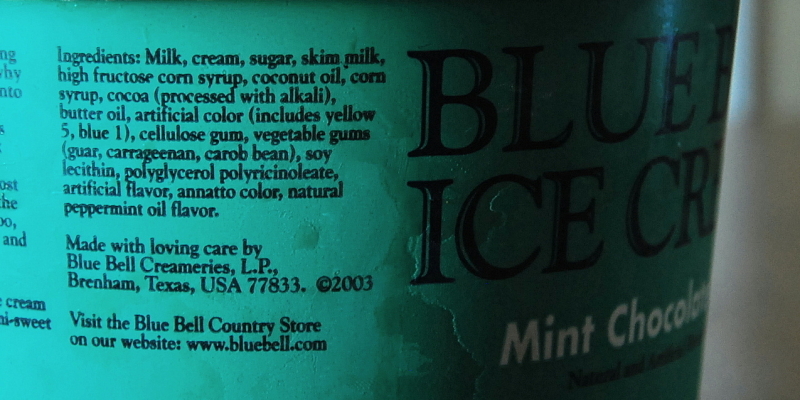According to the American Dietetic Association, only 51% of people pay attention to ingredient labels when purchasing food. Is checking these labels an unnecessary hassle or a critical endeavor? As it turns out, checking labels has become essential to staying healthy, due to the adverse effects of chemicals and other additives in food products. Here are 5 common additives to avoid and why.
1. TBHQ (Tertiary Butylhydroquinone)
TBHQ is a chemical preservative derived from butane, and can be found in a wide variety of things–from Reese’s peanut butter cups to lighter fluid and explosive compounds. According to Natural News, high doses (1-4 grams) of TBHQ can cause nausea, delirium, collapse, ringing in the ears, vomiting, and more. Long term effects of high doses include cancerous precursors and DNA damage.
2. MSG (Monosodium Glutamate)
MSG is a flavor enhancer commonly found in Chinese food, crackers, baby food, meats, seasoning, salad dressing, and much more. According to Dr. Mercola, MSG itself has very little taste at all, but it deceives you into thinking the food you’re eating tastes better than it actually does, by using a little-known fifth basic taste, umami. This sounds like a lucky discovery, until you consider the side effects. Neurosurgeon Russell Blaylock explains that MSG is an excitotoxin–a toxin causing damage to cells through over-excitement. This results in brain damage of varying degrees, and also triggers or worsens disabilities. “What was discovered,” Dr. Blaylock explains, “…is that [MSG caused] silent damage to the brain in which there were few symptoms. Over time, we saw destruction of major portions of the brain–things that could cause Alzheimer’s disease, Parkinson’s,” and other such disabilities.
3. Trans-fats (Trans-fatty Acids)
Trans-fats are an artificial fat, created by adding hydrogen to oil. This process extends shelf life by converting vegetable oil into a solid fat. Trans-fatty acids can be found in foods such as margarine sticks, microwave popcorn, frozen dinners, and anything fried or battered. According to the American Heart Association, trans-fats “raise your bad cholesterol levels and lower your good cholesterol levels. Eating trans-fats increases your risk of developing heart disease and stroke. It’s also associated with a higher risk of developing type 2 diabetes.” Mischievously, companies can label their food products as ‘trans-fat free’ if the serving size is at or below 0.5 grams. Thus, companies will often lower the serving sizes on their packages rather than actually removing trans-fats from their products.
4. HFCS (High Fructose Corn Syrup)
HFCS is an artificial sweetener found in nearly everything–ice cream, jams, ketchup, cereal, syrup, and so on. Due to purposeful confusion implemented through advertising campaigns, whether or not this artificial sweetener causes harm is a much debated issue. Commercials claim HFCS is simply made from corn–therefore “natural”, no different than cane sugar, and fine in moderation. However, this additive is far from natural, and fact checking proves that consumption can cause diabetes, metabolic syndrome, immune system damage, heart disease, mercury poisoning, obesity, cancer, dementia, and liver failure.
5. Sodium Nitrate
Sodium Nitrate is a preservative used to retain color and prevent bacterial growth in food such as bacon, sausage, and processed meats. In fact, processed meats contain 4 times more sodium and 50% more nitrate preservatives than unprocessed meats. According to a study by Harvard School of Public Health, eating such meats increases your risk of developing diabetes by 19%, and risk of developing heart disease by 42%. Contrastingly, consumption of unprocessed red meats does not increase such risk factors. Reneta Micha, who orchestrated this study, concludes, “to lower risk of heart attacks and diabetes, people should consider which types of meats they are eating. Processed meats such as bacon, salami, sausages, hot dogs and processed deli meats may be the most important to avoid. Based on our findings, eating one serving per week or less would be associated with relatively small risk.”
Conclusion:
Harry S. Truman once said, “If you can’t convince them, confuse them.” HFCS ads may have the effrontery to tell us to “get the facts”, but that does not mean they actually have them right. Additionally, simply because an ingredient is FDA approved does not make it safe to ingest. Additives and chemical ingredients may make food cheaper, longer lasting, and better looking–but they also threaten the health of consumers. To protect your health, it is critical to research the facts, read ingredient labels, and buy from trustworthy providers.
Whenever making changes to your diet, exercise and lifestyle, you should always consult a medical professional for advice.
Chana Elizabeth Bainter
Image Credits: Chana Elizabeth Bainter







